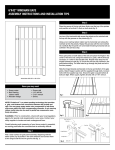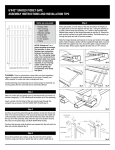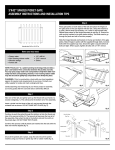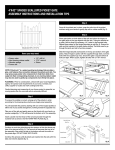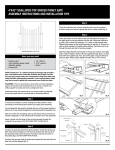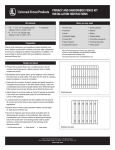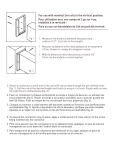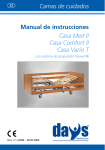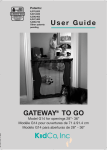Download none 181978 Instructions / Assembly
Transcript
6'X42" SHADOWBOX GATE ASSEMBLY INSTRUCTIONS AND INSTALLATION TIPS Items you may need: • Soapy water •Non-marring rubber mallet • Wooden wedge • Power drill • 1/4" drill bit • 7/16" wrench •Shims Actual size: 68-1/2"h x 41-1/2"w NOTE: PicketLock™ is a patent-pending technology that provides a glue- and fastener-free connection between the pickets and rails. You may spray soapy water onto components to help them slide more easily into their corresponding channels. A non-marring rubber mallet may also be used to gently tap components more firmly into place. Step 5 Place the remaining three pickets on top of the two rails, ensuring the pickets are facing in the same direction. While applying even pressure on the pickets, snap each onto the rails (fig. 5). Step 6 Stand up the gate assembly. Insert the T-rail into the channel at the top of the panel assembly (fig. 6). Slide the T-rail all the way over (fig. 7). Using the rails as a guide, center the bracket to each rail. With the bracket as a guide, drill the (3) necessary holes for the bracket through bolts. Ensure the pickets are fully secured to the rails before drilling. Repeat these steps for the hinge brackets as well (fig. 8). The through bolts must go through the picket and rail to function properly. Connect the through bolts with the supplied cap nuts. Ensure the gate is square before all bolts are tight. When square, tighten all cap nuts with a 7/16" wrench. fig. 1 PLANNING: Prior to construction, check with your local regulatory agency for special code requirements in your area. Contact your utility supplier to locate and mark underground lines. Careful planning and measuring of your fence project is essential, as moving posts after the concrete sets is extremely difficult. fig. 2 fig. 4 fig. 3 fig. 5 Step 1 Find a hard, clean and dry surface for panel assembly. You may want to place a protective drop cloth on your work surface. Each picket is notched; the top of the picket has a single notch, the bottom of the picket has a double notch. Lay out four pickets in the same direction with space in between as shown (fig. 1). Step 2 Place one of the rails across the pickets at the bottom of the panel assembly. Align the tabs of the rails with the notches in the pickets (fig. 2). fig. 6 fig. 7 Step 3 Apply even pressure to the rail, snapping the tabs into the picket notches (fig. 3). You can use a non-marring rubber mallet to more firmly join the rail to the pickets. Continue until all the rail tabs are snapped into the picket notches. Through Bolts Hinged Bracket Cap Nuts Bracket Step 4 Repeat Step 3 to join the second rail to the pickets in the middle of the panel assembly (fig. 4). fig. 8 Digging Post Holes Dig post hole for the hinge post 18" to 24" in diameter and 36" to 42" deep (depending on local ordinance or expected frost depth in winter). We recommend that you insert a piece of 4x4 treated lumber to support the gate hinge post (fig. 9). Check measurement of gate. Actual width of the gate is 41-1/2". The inside post-to-post dimension is 42-3/4". This will give you a 5/8" gap on both sides of the gate to the posts. DOUBLE-CHECK ALL MEASUREMENTS! Installing the Gate Measure to be sure you can install the gate to the post with approximately a 2" gap from the ground to the bottom of the gate. Align the rails on the gate to the rails on the fence panels. fig. 9 Hang the gate between the posts. Use a 5/8" spacer between the gate and the posts (fig. 10). Secure in place with shims under the gate or clamp the gate to the post. Make sure the gate is level and square. Attach hinge brackets to the gate post with the provided screws (fig. 11). Remove any clamps and shims. Attach latch using screws provided (fig. 12). Install a post cap on each post using PVC cement or an exterior adhesive. NOTE: The gate latch is designed to be used on the left- or right-hand side of the gate, depending on customer preference or design. The latch is assembled and ready to be installed on the right-hand side of the gate. If you desire to switch the latch, follow these simple steps: • Remove the 2 shoulder bolts and spring • Change the orientation of the striker fig. 10 • Reattach the spring and insert the shoulder bolts •Shoulder bolts must be fully tightened. Thread-locking adhesive is recommended. fig. 11 fig. 12 THE DIAGRAMS AND INSTRUCTIONS IN THIS BROCHURE ARE FOR ILLUSTRATION PURPOSES ONLY AND ARE NOT MEANT TO REPLACE A LICENSED PROFESSIONAL. ANY CONSTRUCTION OR USE OF THE PRODUCT MUST BE IN ACCORDANCE WITH ALL LOCAL ZONING AND/OR BUILDING CODES. THE CONSUMER ASSUMES ALL RISKS AND LIABILITY ASSOCIATED WITH THE CONSTRUCTION OR USE OF THIS PRODUCT. THE CONSUMER OR CONTRACTOR SHOULD TAKE ALL NECESSARY STEPS TO ENSURE THE SAFETY OF EVERYONE INVOLVED IN THE PROJECT, INCLUDING, BUT NOT LIMITED TO, WEARING THE APPROPRIATE SAFETY EQUIPMENT. EXCEPT AS CONTAINED IN THE WRITTEN LIMITED WARRANTY, THE WARRANTOR DOES NOT PROVIDE ANY OTHER WARRANTY, EITHER EXPRESS OR IMPLIED, AND SHALL NOT BE LIABLE FOR ANY DAMAGES, INCLUDING CONSEQUENTIAL DAMAGES. ©2014 Universal Forest Products, Inc. All rights reserved. 2801 E. Beltline NE, Grand Rapids, MI 49525 800.332.5724 7807_7/14 www.ufpi.com PUERTA SHADOWBOX DE 6'X42" INSTRUCCIONES DE MONTAJE Y CONSEJOS DE INSTALACIÓN Artículos que usted puede necesitar: • Agua jabonosa •Mazo de goma para no dejar marcas • Cuña de madera • Taladro eléctrico • Broca de 1/4" • Llave inglesa de 7/16" •Cuñas Tamaño real: 68-1/2" de alto x 41-1/2" de ancho NOTA: PicketLock™ es una tecnología cuya patente está en trámites que proporciona una conexión libre de pegamento y sujetadores entre las estacas y barandales. Usted puede rociar agua jabonosa en los componentes para ayudar a que se deslicen más fácilmente en sus correspondientes canales. Un mazo de goma que no deje marcas también se puede utilizar para golpear suavemente los componentes para fijarlos más firmemente en su lugar. Paso 5 Coloque las tres estacas restantes arriba de los dos barandales, lo que garantiza que las estacas estén en la misma dirección. Mientras aplica una presión uniforme sobre las estacas, empuje cada una hacia los barandales (fig. 5). Paso 6 Ponga en pie el conjunto de la puerta. Inserte el barandal en forma de T en el canal en la parte superior del conjunto del panel (fig. 6). Deslice el barandal en T hasta el otro extremo (fig. 7). Usando el barandal como guía, centre el soporte a cada barandal. Utilizando el soporte como guía, perfore los tres (3) agujeros necesarios de 1/4" para los pernos del soporte. Verifique que las estacas estén totalmente aseguradas a los barandales antes de taladrar. Repita estos pasos para los soportes de bisagras también (fig. 8). Los pernos pasantes tienen que ir a través de la estacas y el barandal para que funcionen correctamente. Conecte los pernos pasantes con las tuercas ciegas suministradas. Asegúrese de que la puerta esté cuadrada antes de ajustar todos los pernos. Cuando esté cuadrada, ajuste todas las tuercas ciegas con una llave inglesa de 7/16". fig. 1 PLANIFICACIÓN: Antes de la construcción, consulte con su organismo regulador local para los requisitos especiales de los códigos en su área. Póngase en contacto con su proveedor de servicios básicos para localizar y marcar las líneas subterráneas. La cuidadosa planificación y medición de su proyecto de cercas es esencial, ya que mover los postes después de que el concreto se asienta es extremadamente difícil. Paso 1 fig. 2 fig. 4 fig. 3 fig. 5 Encuentre una superficie dura, limpia y seca para el montaje del panel. Es posible que desee colocar una lona protectora sobre su superficie de trabajo. Cada estaca tiene una ranura; la parte superior de la estaca tiene una sola ranura, la parte inferior de la estaca tiene una ranura doble. Coloque cuatro estacas en la misma dirección con espacio entre ellas como se muestra (fig. 1). Paso 2 Coloque uno de los barandales perpendicularmente a las estacas en la parte inferior del conjunto del panel. Alinee las pestañas de los barandales con las ranuras en las estacas (fig. 2). fig. 6 fig. 7 Paso 3 Aplique una presión uniforme al barandal, presionando las pestañas en las ranuras de las estacas (fig. 3). Usted puede utilizar un mazo de goma que no deje marcas para unir más firmemente el barandal a las estacas. Continúe hasta que todas las pestañas del barandal queden sujetas a las ranuras de las estacas. Pernos pasantes Soportes de bisagra Tuercas ciegas Soportes Paso 4 Repita el paso 3 para unir el segundo barandal a las estacas en el centro del conjunto del panel (fig. 4). fig. 8 Excavación de los hoyos para los postes Apertura de puerta Cave un hoyo para el poste de bisagra de 18" a 24" de diámetro y de 36" a 42" de profundidad (dependiendo de la ordenanza local o la profundidad de la helada esperada en invierno). Le recomendamos que inserte una pieza de 4x4 de madera tratada para soportar el poste de bisagra de la puerta (fig. 9). Poste de bisagra Poste de pestillo Pieza de madera de 4x4 Compruebe la medida de la puerta. El ancho real de la puerta es 41-1/2". La dimensión interior poste-a-poste es de 42-3/4". Esto le dará un espacio de 5/8" de ambos lados de la puerta a los postes. ¡VUELVA A REVISAR TODAS LAS MEDIDAS! 18"- 24" de diámetro. Hoyo lleno de concreto Instalación de la puerta 36" a 42" Bases de apoyo Mida para asegurarse de que puede instalar la puerta al poste con una brecha de aproximadamente 2" desde el suelo hasta la parte inferior de la puerta. Alinee los barandales de la puerta con los barandales de los paneles de la cerca. Cuelgue la puerta entre los postes. Utilice un distanciador de 5/8" entre la puerta y los postes (fig. 10). Asegure en su lugar con cuñas debajo de la puerta o sujete la jamba de la puerta al poste con abrazaderas. Asegúrese de que la puerta esté nivelada y cuadrada. Fije los soportes de bisagra al poste de la puerta con los tornillos suministrados (fig. 11). fig. 9 Poste de bisagra Plancha de cerradura Pestillo Poste de pestillo Retire las abrazaderas y las cuñas. Fije el pestillo utilizando los tornillos suministrados (fig. 12). Instale el tope del poste con cemento de PVC o un adhesivo exterior. Distanciador de 5/8" NOTA: El pestillo de la puerta está diseñado para ser utilizado en el lado izquierdo o derecho de la puerta, dependiendo de la preferencia o diseño del cliente. El pestillo está montado y listo para ser instalado en el lado derecho de la puerta. Si usted desea cambiar el pestillo, siga estos sencillos pasos: • Quite los 2 pernos de ajuste y el resorte • Cambie la orientación de la plancha de cerradura Nivel del suelo • Vuelva a colocar el resorte e inserte los pernos de ajuste fig. 10 •Los pernos de ajuste deben estar bien apretados. Se recomienda un adhesivo fijador de roscas. Soportes de bisagras Centrar en los barandales superiores e inferiores Pestillo Plancha de cerradura fig. 11 fig. 12 LOS DIAGRAMAS E INSTRUCCIONES DE ESTE FOLLETO SON PARA FINES ILUSTRATIVOS SOLAMENTE Y NO ESTÁN DESTINADOS A REEMPLAZAR A UN PROFESIONAL MATRICULADO. CUALQUIER CONSTRUCCIÓN O USO DEL PRODUCTO DEBEN ESTAR DE ACUERDO CON TODOS LOS CÓDIGOS LOCALES DE CONSTRUCCIÓN O DE ZONIFICACIÓN. EL USUARIO ASUME TODOS LOS RIESGOS Y RESPONSABILIDADES ASOCIADOS CON LA CONSTRUCCIÓN O EL USO DE ESTE PRODUCTO. EL USUARIO O CONTRATISTA DEBEN TOMAR TODAS LAS MEDIDAS NECESARIAS PARA GARANTIZAR LA SEGURIDAD DE TODAS LAS PERSONAS INVOLUCRADAS EN EL PROYECTO, INCLUIDO, ENTRE OTROS, EL USO DEL EQUIPO DE SEGURIDAD APROPIADO. A EXCEPCIÓN DE LO CONTENIDO EN LA GARANTÍA LIMITADA POR ESCRITO, EL GARANTE NO PROPORCIONA NINGUNA OTRA GARANTÍA, YA SEA EXPRESA O TÁCITA, Y NO SERÁ RESPONSABLE DE NINGÚN DAÑO, INCLUIDOS DAÑOS CONSECUENTES. ©2014 Universal Forest Products, Inc. Todos los derechos reservados. 2801 E. Beltline NE, Grand Rapids, MI 49525 800.332.5724 7807_7/14 www.ufpi.com
This document in other languages
- español: none 181978





